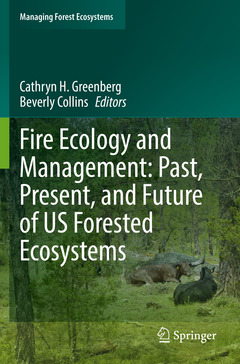Fire Ecology and Management: Past, Present, and Future of US Forested Ecosystems, 1st ed. 2021 Managing Forest Ecosystems Series, Vol. 39

This edited volume presents original scientific research and knowledge synthesis covering the past, present, and potential future fire ecology of major US forest types, with implications for forest management in a changing climate. The editors and authors highlight broad patterns among ecoregions and forest types, as well as detailed information for individual ecoregions, for fire frequencies and severities, fire effects on tree mortality and regeneration, and levels of fire-dependency by plant and animal communities.
The foreword addresses emerging ecological and fire management challenges for forests, in relation to sustainable development goals as highlighted in recent government reports. An introductory chapter highlights patterns of variation in frequencies, severities, scales, and spatial patterns of fire across ecoregions and among forested ecosystems across the US in relation to climate, fuels, topography and soils, ignition sources (lightning or anthropogenic), and vegetation. Separate chapters by respected experts delve into the fire ecology of major forest types within US ecoregions, with a focus on the level of plant and animal fire-dependency, and the role of fire in maintaining forest composition and structure. The regional chapters also include discussion of historic natural (lightning-ignited) and anthropogenic (Native American; settlers) fire regimes, current fire regimes as influenced by recent decades of fire suppression and land use history, and fire management in relation to ecosystem integrity and restoration, wildfire threat, and climate change. The summary chapter combines the major points of each chapter, in a synthesis of US-wide fire ecology and forest management into the future.
This book provides current, organized, readily accessible information for the conservation community, land managers, scientists, students and educators, and others interested in how fire behavior and effects on structure and composition differ among ecoregions and forest types, and what that means for forest management today and in the future.
Chapter 1. Introduction to Fire Ecology across USA Forested Ecosystems: Past, Present, and Future (Cathryn H. Greenberg, Beverly S. Collins, Scott Goodrick, Michael C. Stambaugh, and Gary R. Wein).- Chapter 2. The Role of Fire in the Dynamics of Piedmont Vegetation (Joanna Spooner, Robert K. Peet, Michael P. Schafale, Alan S. Weakley and Thomas R. Wentworth).- Chapter 3. Fire Ecology and Fire Management of Southeastern Coastal Plain Pine Ecosystems (Jeff S. Glitzenstein, J. Stephen Brewer, Ronald. E. Masters, J. Morgan Varner, and J. Kevin Hiers).- Chapter 4. Fire Ecology and Management in Eastern Broadleaf and Appalachian Forests (Mary A. Arthur, J. Morgan Varner, Charles W. Lafon, Heather D. Alexander, Daniel C. Dey, Craig A. Harper, Sally P. Horn, Todd F. Hutchinson, Tara L. Keyser, Marcus A. Lashley, Christopher E. Moorman, and Callie J. Schweitzer).- Chapter 5. Fire Ecology and Management of Forest Ecosystems in the Western Central Hardwoods and Prairie-Forest Border (Michael C. Stambaugh, Benjamin O. Knapp, and Daniel C. Dey).- Chapter 6. Fire in Floodplain Forests of the Southeastern USA hy (Paul R. Gagnon, Loretta L. Battaglia, Brice B. Hanberry, William H. Conner, and Sammy L. King).- Chapter 7. History and Future of Fire in Hardwood and Conifer Forests of the Great Lakes-Northeastern Forest Region, USA(Lee E. Frelich, Craig G. Lorimer, and Michael C. Stambaugh).- Chapter 8. Fire Ecology of Rocky Mountain Forests(Sharon M. Hood, Brian J. Harvey, Paula J. Fornwalt, Cameron E. Naficy, Winslow D. Hansen, Kimberley T. Davis, Mike A. Battaglia, Camille Stevens-Rumann, Victoria Saab).- Chapter 9. Fire Ecology of the North American Mediterranean-Climate Zone(Hugh D. Safford, Ramona J. Butz, Gabrielle N. Bohlman, Michelle Coppoletta, Becky L. Estes, Shana E. Gross, Kyle E. Merriam, Marc D. Meyer, Nicole A. Molinari, and Amarina Wuenschel).- Chapter 10. Fire Ecology and Management in Pacific Northwest Forests(Matthew J. Reilly, Jessica E. Halofsky, Meg A. Krawchuk, Daniel C. Donato, Paul F. Hessburg, James Johnston, Andrew Merschel, Mark E. Swanson, Joshua S. Halofsky, and Thomas A. Spies).- Chapter 11. Fire Ecology and Management of Southwestern Forests(Peter Z. Fulé, Catrin M. Edgeley, Carol L. Chambers, Serra Hoagland, Blanca Céspedes).- Chapter 12. Fire and Forests in the 21st Century: Managing Resilience under Changing Climates and Fire Regimes in USA Forests(James M. Vose, David L. Peterson, Christopher J. Fettig, Jessica E. Halofsky, J. Kevin Hiers, Robert E. Keane, Rachel Loehman, and Michael C. Stambaugh).
Relevant for the UN Sustainable Development Goal 15: Life on Land
Broad overview and comparison of ecosystem/ecoregion-specific fire regimes (frequency, severity, scale, spatial patterns) across US forest types
Provides perspective on how climate change may alter fire regimes and forests in the future
Useful and informative to ecologists and forest managers striving to sustain forest communities
Focus on a ubiquitous disturbance - fire - as a driver of forest composition across differing levels of fire-dependency of plant and animal communities
Date de parution : 10-2022
Ouvrage de 502 p.
15.5x23.5 cm
Date de parution : 10-2021
Ouvrage de 502 p.
15.5x23.5 cm



